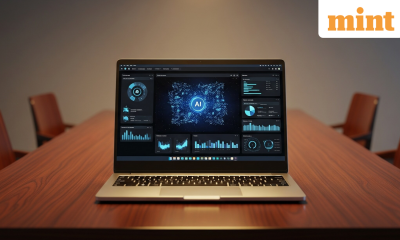

Metaverse
How AI could create the first one-person unicorn – Crypto News
Sarah Gwilliam is neither a software engineer nor, she confesses, does she “speak AI”. But after her father died recently she got the spark of an idea for creating a generative artificial-intelligence startup that would help others like her handle their grief and sort out their late loved ones’ affairs. Call it wedding planning for funerals.
Her firm, Solace, is still more of an early-stage startup than an established business. But besides herself, almost no human being is helping her build it. She has joined an AI-powered incubator, Audos, which decided her idea was promising. Its bots helped to set her up online and on Instagram. If her idea works out, the incubator will not only provide capital; its AI agents will support Ms Gwilliam with product development, sales, marketing and back-office work, all in exchange for a royalty. She does not need staff. In effect, AI helped her co-found the company. “I can’t tell you how empowering it was,” she says.
As is its custom, Silicon Valley has already adopted a neologism that describes one-person founders like Ms Gwilliam: they are “solopreneurs”. In tech circles, there are bets on which of them is likely to create the first single-person unicorn—an unlisted firm worth more than $1bn. Some hope that generative AI will make starting a business so cheap and hassle-free that anyone will be able to become an entrepreneur much as anyone can become a YouTuber—a breath of fresh air in America’s concentrated business landscape. Whether people like Ms Gwilliam will be able to escape the suffocating grip of the tech giants, however, is another matter.
Technological revolutions have a habit of shaking up the way firms do business. The increased importance of machinery combined with the expansion of transport networks in the late 19th century led to the rise of giant corporations. Ronald Coase, a British economist, argued in his 1937 paper “The Nature of the Firm” that their existence was a testament to the efficiency of consolidating and managing work within the confines of a business, rather than outsourcing activities to the market. That, however, began to change with the rise of digital communications. Not only could companies more easily outsource manufacturing and back-office jobs to low-cost countries. They could also rely on internet platforms like Google for marketing and Amazon Web Services for computing.
The rise of AI could well accelerate the trend, as semi-autonomous agents provided by Silicon Valley enable firms to perform the same amount of work with fewer employees. Henrik Werdelin, who co-founded Audos, says that the rise of cloud computing helped him start several new businesses over the past 20 years or so with little more than the swipe of a credit card to get going. He describes AI as the next wave in that “democratisation”. “You don’t need to code, you don’t need to be able to use Photoshop, because you can get AI to help with that.” This, he hopes, will give rise to a flood of startups built by people like Ms Gwilliam with no background in technology but who have identified real problems to solve.
Another evangelist is Karim Lakhani of Harvard Business School. It now offers a leadership course for executives in which they use generative AI to build a snack-food company in 90 minutes, using the technology to perform customer research, generate recipes, find suppliers and design packaging. In a recent paper, Mr Lakhani and his co-authors presented a field trial in which 776 professionals at Procter & Gamble, a consumer-goods company, were asked to address a real business need either individually or in two-person teams, with and without using generative-AI tools. It found that AI significantly boosted performance, helping individuals with AI match the performance of teams without it. AI proved to be more of a “teammate” than a tool.
With the era of free money over, founders are eager to find ways to keep costs down. Peter Walker of Carta, which helps startups manage equity ownership, says that founders used to boast about how many employees they had. “Now it’s a badge of honour to say, ‘look how few people work for me’.” According to Carta’s data, the median period it takes founders to hire their first employee after their startup incorporates has risen from less than six months in 2022 to more than nine months in 2024 (see chart). Base44, an AI-native coding startup, made headlines recently when it was sold to Wix, a web-development platform, for $80m. It had just eight employees.
It is early days, of course. For one thing, AI agents are far from foolproof. In June Anthropic, an AI lab, revealed the results of an experiment in which its Claude Sonnet model operated a vending machine at the company’s headquarters. The bot’s goal was to avoid bankruptcy. It was good at identifying suppliers and adapting to user requests (including hunting for a tungsten cube mischievously requested by one employee). But it ignored lucrative opportunities, hallucinated, offered too many discounts and ultimately failed to make money.
Other forces may also get in the way of an AI-infused surge in entrepreneurship. Despite the growth of the internet, social media, software-as-a-service and cloud computing over the past three decades, business formation in America was anaemic until the pandemic—the result in part of an ageing population. That demographic pressure will only intensify.
For all the promise of generative AI, it poses problems for entrepreneurs, too. Annabelle Gawer of the University of Surrey notes that although the technology lowers barriers to entry for new businesses, it also makes it easier to quickly copy ideas. Unless a founder has unique expertise in their domain, that may make it harder to sustain a competitive advantage.
Moreover, the provision of AI tools is dominated by tech giants and the labs they invest in, such as OpenAI, backed by Microsoft, and Anthropic, backed by Amazon and Google. Ms Gawer draws an analogy with the rise of cloud computing in the 2010s, which those three tech giants dominate. Although that infrastructure has made life easier for startups, it has also left them dependent on the cloud triumvirate, which has been able to capture a good share of the value these firms have generated. Last year the trio’s net profits were equivalent to 7% of America’s total, up from 2% a decade before.
Another galling possibility is that the tech giants could pinch smaller companies’ best ideas. For now, Ms Gwilliam of Solace is sanguine. What she calls “first-mover disadvantage” could be “a bummer”, but it could also validate her idea. “Maybe they’ll come to me and say, ‘We want Solace.’ And then I’ll be, like, ‘Great, sold!’” Just like a typical entrepreneur, then.
-

 Blockchain1 week ago
Blockchain1 week agoXRP ETFs Listed On DTCC Ahead Of Possible Launch – Crypto News
-

 Blockchain1 week ago
Blockchain1 week agoEthereum (ETH) Holds Strong as Analysts Target $4,400 Despite ETF Outflows – Crypto News
-

 Cryptocurrency6 days ago
Cryptocurrency6 days agoVanEck’s Solana ETF nears launch after SEC 8-A filing – Details – Crypto News
-

 Cryptocurrency6 days ago
Cryptocurrency6 days agoVanEck’s Solana ETF nears launch after SEC 8-A filing – Details – Crypto News
-
Technology1 week ago
Breaking: Coinbase Launches Token Sales Platform for Retail Investors – Crypto News
-
Business5 days ago
December Fed Meeting 2025: Rate Cut or Hold? Key levels to Watch – Crypto News
-
Business1 week ago
Breaking: Coinbase Launches Token Sales Platform for Retail Investors – Crypto News
-

 De-fi7 days ago
De-fi7 days agoZEC Jumps as Winklevoss‑Backed Cypherpunk Reveals $100M Zcash Treasury – Crypto News
-

 Metaverse1 week ago
Metaverse1 week agoWhat’s in India’s first AI rulebook? – Crypto News
-

 Cryptocurrency1 week ago
Cryptocurrency1 week agoHow Strive’s $162M Bitcoin bet could make it the next MicroStrategy – Crypto News
-
others5 days ago
December Fed Meeting 2025: Rate Cut or Hold? Key levels to Watch – Crypto News
-

 Metaverse5 days ago
Metaverse5 days agoClaude Desktop is your new best friend for an organized PC – Crypto News
-

 Cryptocurrency1 week ago
Cryptocurrency1 week agoBitcoin faces quantum risk: why SegWit wallets may offer limited protection – Crypto News
-

 De-fi6 days ago
De-fi6 days agoKraken’s xStocks Hit $10B in Total Trading Volume – Crypto News
-

 Blockchain1 week ago
Blockchain1 week agoSquare Enables Bitcoin Payments for Sellers – Crypto News
-

 De-fi1 week ago
De-fi1 week agoBitcoin Hovers Around $105,000 as Government Shutdown Progress Lifts Markets – Crypto News
-
others1 week ago
Breaking: Canary XRP ETF Gets Approval with 8-A Filing to List on Nasdaq – Crypto News
-

 Metaverse1 week ago
Metaverse1 week agoYour deep research tool may save you time, but can it save you embarrassment? – Crypto News
-

 De-fi1 week ago
De-fi1 week agoXPL Rallies After Plasma Reveals Collaboration with Daylight Energy – Crypto News
-

 De-fi1 week ago
De-fi1 week agoSKY Surges 14% as Savings TVL Passes $4 Billion – Crypto News
-

 Metaverse5 days ago
Metaverse5 days agoClaude Desktop is your new best friend for an organized PC – Crypto News
-

 Technology1 week ago
Technology1 week agoEU Eyes Banning Huawei From Mobile Networks of Member Countries – Crypto News
-

 De-fi1 week ago
De-fi1 week agoMonad Faces Community Backlash After Unveiling Tokenomics – Crypto News
-

 others1 week ago
others1 week agoGold retreats from three-week high but retains bullish outlook – Crypto News
-

 De-fi1 week ago
De-fi1 week agoThreshold Network Upgrades tBTC Bridge to Link Institutional Bitcoin with DeFi – Crypto News
-

 De-fi1 week ago
De-fi1 week agoEthereum Sees First Sustained Validator Exit Since Proof-of-Stake Shift – Crypto News
-

 Cryptocurrency1 week ago
Cryptocurrency1 week agoXRP’s Big Moment? Why Nov. 13 Could Be the Day Ripple Investors Have Waited For – Crypto News
-

 De-fi1 week ago
De-fi1 week agoTrump Tokens Outperform After US President Teases ‘Tariff Dividends’ – Crypto News
-

 Metaverse1 week ago
Metaverse1 week agoFoxconn reports strong Q3 profit driven by AI server boom, teases OpenAI announcement – Crypto News
-

 Cryptocurrency1 week ago
Cryptocurrency1 week agoBitcoin (BTC) battles macro headwinds despite improved ETF inflows – Crypto News
-

 Blockchain7 days ago
Blockchain7 days agoWhy the Future of Blockchain Payments Could Stay Narrow – Crypto News
-

 others1 week ago
others1 week agoAustralian Dollar loses ground despite stronger Westpac Consumer Confidence – Crypto News
-
others1 week ago
Bitcoin News: BTC Exchange Reserves Fall as Tether Mints $1B USDT – Crypto News
-

 Blockchain1 week ago
Blockchain1 week agoXRP Price Resumes Uptrend Amid Renewed Market Optimism and Whale Activity – Crypto News
-

 De-fi1 week ago
De-fi1 week agoInstitutional Sentiment is Turning Bearish on Crypto: Sygnum – Crypto News
-
Cryptocurrency1 week ago
Can Dogecoin Price Hold Above $0.17 Amid Weekly Surge? – Crypto News
-

 Technology1 week ago
Technology1 week agoChinas cryptoqueen jailed in UK over $6.6 billion Bitcoin scam – Crypto News
-

 Blockchain1 week ago
Blockchain1 week agoBitcoin Path To $1 Million Clears With OG Sellers Fading: Weisberger – Crypto News
-
Technology1 week ago
Breaking: USDC Issuer Circle Explores Native Token for Arc Network – Crypto News
-
others1 week ago
Hyperliquid Halts Deposits and Withdrawals Amid POPCAT Liquidation Saga – Crypto News
-
Business1 week ago
Hyperliquid Halts Deposits and Withdrawals Amid POPCAT Liquidation Saga – Crypto News
-

 De-fi1 week ago
De-fi1 week agoFlare TVL Nears Record High as Firelight Teases XRP Liquid Staking – Crypto News
-

 Cryptocurrency1 week ago
Cryptocurrency1 week agoAI-driven phishing scams and hidden crypto exploits shake Web3 security – Crypto News
-

 De-fi6 days ago
De-fi6 days agoXRP Surges as First US Spot ETF Debuts on Nasdaq – Crypto News
-

 Cryptocurrency6 days ago
Cryptocurrency6 days agoUAE makes Bitcoin wallets a crime risk in global tech crackdown – Crypto News
-

 De-fi5 days ago
De-fi5 days agoBitcoin Drops to $94,000 Following Second-Largest Daily ETF Outflows – Crypto News
-

 De-fi5 days ago
De-fi5 days agoBitcoin Drops to $94,000 Following Second-Largest Daily ETF Outflows – Crypto News
-

 Technology4 days ago
Technology4 days agoPerplexity faces harsh crowd verdict at major San Francisco AI conference: ‘Most likely to flop’ – Crypto News
-
Business1 week ago
Arthur Hayes Buys UNI as CryptoQuant CEO Says Supply Shock ‘Inevitable’ for Uniswap – Crypto News
-
Business1 week ago
U.S. Government Shutdown Set to End as House Panel Approves Senate Funding Deal – Crypto News










